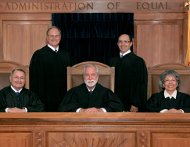6/14/2010
New Mexico Supreme Court Overturns DUI Without DrivingNew Mexico Supreme Court rules that driving under the influence of alcohol charges requires proof of driving or intent to do so.

New Mexico's highest court on Tuesday reversed an interpretation of the driving under the influence of alcohol (DUI) statute that had discouraged motorists from sleeping off a night of drinking in their automobile. In December 2004, a police officer came upon Mark Sims who was asleep in the driver's seat of his car, which was legally parked in a commercial parking lot. Although the car keys were on the passenger seat and not in the ignition, a trial court and the court of appeals found him guilty of being in "actual physical control" of the vehicle.
"Under settled law, defendant had actual physical control if he could exercise direct influence over the vehicle," a divided court of appeals ruled. "Based on the facts of this case, there was nothing to prevent defendant from awakening, reaching for the keys, and driving from the parking lot."
The supreme court explained that this interpretation of "actual physical control" developed as a means of convicting people who had obviously driven their car while drunk but outside the view of a police officer. For example, it is obvious that a man passed out in his car in the middle of an intersection with the engine running got there by driving. The line of thought was extended to make having the potential to drive drunk in the future a crime. Justices decided such interpretations departed from the true purpose of the DUI laws.
"The threat, if any, that was posed by defendant as he lay passed out or asleep in his vehicle was far short of that posed by an intoxicated individual who is driving," Justice Edward L. Chavez wrote for the court. "While defendant arguably exercised some level of control over the vehicle, given his location in the driver's seat and the proximity of his keys, there was no indication that he posed any actual, as opposed to hypothetical, threat to the public."
The supreme court pointed out that prior court DUI decisions taken to an extreme make the roads less safe, not more safe.
"For example, on a cold night, an intoxicated person may use his vehicle as a temporary shelter -- as a place to sleep it off -- even going so far as to start the engine so that he can turn on the heater," Justice Chavez wrote. "Such an individual, while clearly in control of his vehicle, does not pose a threat to himself, herself, or the public precisely because he has decided not to drive. The individual's recognition that he is too intoxicated to drive embodies the aim of our DWI law and its enforcement. To subject this type of behavior to strict liability would be counterproductive."
As a result, the supreme court ruled that when an individual is arrested for DUI based on "actual physical control" of the vehicle -- as opposed to actually driving the vehicle -- the state must prove that the defendant actually intended to drive. Without making this distinction, drunks would be encouraged to take their chances on the road by driving home since the penalty would be the same as for sleeping it off in the car.
"The facts of this case exemplify how this language could be misinterpreted to allow a conviction for conduct the legislature did not intent to proscribe," Chavez wrote. "Otherwise, rather than driving while intoxicated, it would be parked while intoxicated."
The high court acknowledged that the new procedure set out in this decision will increase the burden on the prosecution and that police will have to gather evidence with greater care.
"A fact finder cannot simply assume or speculate that the individual in question might sometime in the future commence driving his or her vehicle," Chavez wrote. "Instead, the fact finder must assess the totality of the circumstances and find that (1) the defendant was actually, not just potentially, exercising control over the vehicle, and (2) the defendant had the general intent to drive so as to pose a real danger to himself, herself, or the public. In this case, the state failed to prove that defendant used the vehicle other than as a passive occupant. It was pure speculation whether defendant would rouse himself and drive the vehicle. Defendant could not be convicted for what he might have done. The state had to prove beyond a reasonable doubt that defendant actually exercised physical control over the vehicle with the general intent to drive so as to endanger the public."
Because the state could not do so, the charges against Sims were dismissed. A copy of the decision is available in a 65k PDF file at the source link below.


